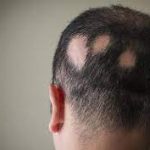Table of Contents
What is hair loss?

Hair loss is a common side effect of cancer treatment. The medical term for hair loss is alopecia. It can happen as a side effect of chemotherapy, targeted therapy, radiation therapy, or a stem cell (bone marrow) transplant. These cancer treatments can harm the cells that help hair growth. It can affect hair all over your body, including your head, face, arms, legs, underarms, and pubic area. Lost hair usually grows back after the completion of cancer treatments.
How bad is my hair loss?
Mild: You may have sudden hair loss of less than 50% or hair thinning; baldness is apparent only on close inspection; an appropriate hairstyle is required to cover the head.
Moderate to severe: You may have hair loss of equal to or more than 50%. Baldness is readily apparent to others. Visit your doctor, if you have sudden hair loss or bald patches or you are losing hair in clumps.
How to manage mild hair loss or alopecia?
Keep track of your hair loss using Ankr (myAnkr web portal or the Ankr app). It will help you describe the hair loss to your doctor or nurse.
- You may choose to cut your hair shorter. A shorter hairstyle may make thin hair look fuller.
- Some people decide to shave their head in advance. This can help wigs or other head coverings fit better.
- If you want to wear a scarf, hat, or other head coverings, get some of those items in advance. This can make you feel more prepared for when it starts happening.
- Some people choose to not cover their thinning hair or bald head, finding it more comfortable or easier to manage in daily life.
- Choose a gentle, fragrance-free shampoo. Avoid washing your hair every day. Wash gently. If your hair tangles, consider using products like a gentle conditioner or detangler spray.
- Pat your hair dry to prevent damage. Avoid pulling on your hair as much as possible. Style it gently with a soft brush or wide-toothed comb.
- When outdoors, use sun protection on your scalp, such as sunscreen, a hat, or a scarf.
- Avoid high-heat styling, chemical curling or straightening, and permanent or semi-permanent hair color.
- Choose a soft, smooth pillowcase.
- Talk with your health care team if you are interested in taking biotin, a type of B vitamin.
How to manage moderate to severe hair loss?
Seek medical help if you
- Have sudden hair fall
- Develop bald patches
- Are losing hair in clumps
- Have itching in head
What are the causes?
- Radiation therapy
- Chemotherapy
- Hormonal therapy
- Targeted therapy
